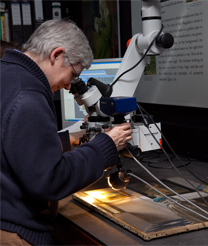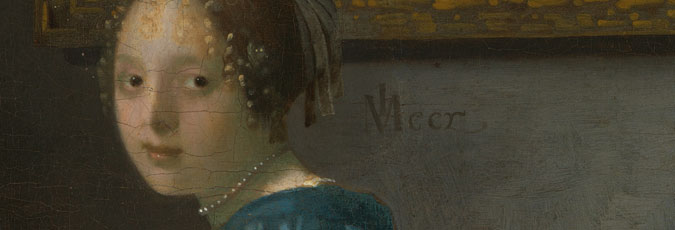About the project
The extended loan of Vermeer's The Guitar Player from Kenwood House enabled National Gallery researchers to analyse the painting's materials and closely study the techniques used. The findings were compared with other late paintings by Vermeer in the National Gallery (A Young Woman seated at a Virginal and A Young Woman standing at a Virginal), and a slightly earlier work ('The Music Lesson') kindly lent by the Royal Collection for the National Gallery's 2013 summer exhibition Vermeer and Music: The Art of Love and Leisure.
This project presented an opportunity for close visual examination and technical imaging of these works. In addition, a small number of paint samples obtained from each of these paintings in the 1960s and archived since that time at the Doerner Institut were kindly loaned for study. Techniques for the analysis of these samples, not available in the 1960s, scanning electron microscopy with energy dispersive X-ray analysis (SEM-EDX) and attenuated total reflectance – Fourier transform infrared (ATR-FTIR) spectroscopy have now been undertaken. The aim has been to draw together information from current visual inspections, analytical evidence from the old paint samples, and the results of the analysis of a very small number of new samples which we have been able to take from our own paintings. The study has been directed to understanding the current condition of the paintings and how this may relate to the alteration of Vermeer’s original painting materials and to conservation treatments undertaken in the past.
Read a full account of the methods used to investigate Vermeer's paintings

The results are presented in two sections. The first section, Original methods and material, outlines the investigation of Vermeer's original materials and techniques. This section is illustrated by numerous photomicrographs revealing how Vermeer meticulously crafted his paintings to achieve their uniquely luminous effect. The second section, Time and transformation, introduces details of how the materials have changed over time and how this affects their present appearance.
Images
All images are copyright of the National Gallery unless stated otherwise.
Images of the four paintings may be enlarged with the Image Viewer, which may be opened in a new window to enable the viewing of enlarged images alongside the topic entry.
View the paintings in the Image Viewer
Authors and contributors
All articles in Vermeer and technique are authored by the National Gallery's Helen Howard, Scientific Officer – Microscopist; David Peggie, Scientific Officer – Organic Analyst; and Rachel Billinge, Research Associate in the Conservation department.
Vermeer and Music: The Art of Love and Leisure is curated by Betsy Wieseman, Curator of Dutch and Flemish Paintings at the National Gallery.
Acknowledgements
Our thanks are due to the Royal Collection Trust (working on behalf of Her Majesty The Queen) and to English Heritage for generously loaning 'The Music Lesson' and 'The Guitar Player' respectively. We are particularly grateful to Desmond Shawe-Taylor (Surveyor of The Queen's Pictures), Nicola Christie and Rosanna de Sancha of the Paintings Conservation Studio at The Royal Collection, and to Dr Susan Jenkins (Senior Curator) and Alice Tate-Harte (Collections Conservator) at English Heritage for their assistance throughout the project. We would also like to thank Nicola Costaras (Head Paintings Conservator, Victoria and Albert Museum), Dr Melanie Gifford (Scientific Research Department, National Gallery of Art, Washington), Jo Kirby-Atkinson (formerly of the Scientific Department, National Gallery, London) and Viola Pemberton-Piggott for sharing their technical expertise with us. We are also indebted to Professor Dr Andreas Burmester, Director of the Doerner Institut, Munich for kindly loaning the paint samples taken from all four paintings in the 1960s and archived since that time at the Doerner Institut.
Explore the topics
Original methods and material
- Support and ground
- Infrared examination
- Vermeer's palette
- Binding medium
- Paint application
- Secrets of the studio
Time and transformation

